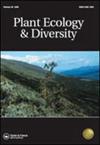Ecological and evolutionary distances from neighbouring plants do not influence leaf herbivory by chewing insects in a Neotropical savanna
IF 1.6
4区 生物学
Q2 PLANT SCIENCES
引用次数: 1
Abstract
ABSTRACT Background Coexisting plant species frequently exhibit marked differences in leaf damage caused by chewing insects. Such variation in leaf herbivory has often been attributed to interspecific differences in leaf defensive traits, leaf nutritional quality and leaf abundance. Aims We aimed to investigate the hypothesis that plants surrounded by more similar neighbours tend to exhibit higher levels of herbivory than plants surrounded by less similar neighbours. Methods We sampled 27 tree and shrub species in 49 plots of 10 m2 located in a Neotropical savanna. For each of the 815 plants sampled, we quantified leaf damage, specific leaf area, leaf toughness, height, and conspecific abundance. We analysed the relationship between herbivory levels and plant traits comparing each individual with its neighbouring plants. The effect of phylogenetic similarity was addressed using the mean phylogenetic distance between a focal plant individual and its neighbours (i.e., the phylogenetic isolation). Results Leaf herbivory damage ranged from zero to 29.6%. We found that phylogenetic isolation, specific leaf area, plant height, and plant abundance were not related to differences in leaf herbivory at the individual level in a neighbourhood. Conclusions Our findings show that leaf herbivory damage of individual plants was not consistently influenced either by phylogenetic or by trait similarity with neighbours.在新热带稀树草原上,与邻近植物的生态和进化距离不影响咀嚼昆虫的叶子食草性
摘要背景共存的植物物种在咀嚼昆虫对叶片造成的伤害上往往表现出显著的差异。这种叶片食草性变异通常归因于叶片防御性状、叶片营养质量和叶片丰度的种间差异。我们的目的是研究一种假设,即被更相似的邻居包围的植物往往比被不太相似的邻居包围的植物表现出更高的食草性水平。方法在新热带热带稀树草原49块10 m2的样地取样27种乔灌木。我们对815株植物的叶片损伤、比叶面积、叶片韧性、叶片高度和同种丰度进行了量化。我们将每个个体与其邻近植物进行比较,分析了草食水平与植物性状之间的关系。系统发育相似性的影响是利用焦点植物个体与其邻居之间的平均系统发育距离(即系统发育隔离)来解决的。结果叶片草食性损害范围为0 ~ 29.6%。系统发育隔离度、比叶面积、株高和植物丰度与群落个体水平上的叶片食草性差异无关。结论单株叶片的食草性损害不受系统发育或与邻居性状相似性的一致影响。
本文章由计算机程序翻译,如有差异,请以英文原文为准。
求助全文
约1分钟内获得全文
求助全文
来源期刊

Plant Ecology & Diversity
PLANT SCIENCES-
CiteScore
3.30
自引率
0.00%
发文量
26
审稿时长
3 months
期刊介绍:
Plant Ecology and Diversity is an international journal for communicating results and novel ideas in plant science, in print and on-line, six times a year. All areas of plant biology relating to ecology, evolution and diversity are of interest, including those which explicitly deal with today''s highly topical themes, such as biodiversity, conservation and global change. We consider submissions that address fundamental questions which are pertinent to contemporary plant science. Articles concerning extreme environments world-wide are particularly welcome.
Plant Ecology and Diversity considers for publication original research articles, short communications, reviews, and scientific correspondence that explore thought-provoking ideas.
To aid redressing ‘publication bias’ the journal is unique in reporting, in the form of short communications, ‘negative results’ and ‘repeat experiments’ that test ecological theories experimentally, in theoretically flawless and methodologically sound papers. Research reviews and method papers, are also encouraged.
Plant Ecology & Diversity publishes high-quality and topical research that demonstrates solid scholarship. As such, the journal does not publish purely descriptive papers. Submissions are required to focus on research topics that are broad in their scope and thus provide new insights and contribute to theory. The original research should address clear hypotheses that test theory or questions and offer new insights on topics of interest to an international readership.
 求助内容:
求助内容: 应助结果提醒方式:
应助结果提醒方式:


